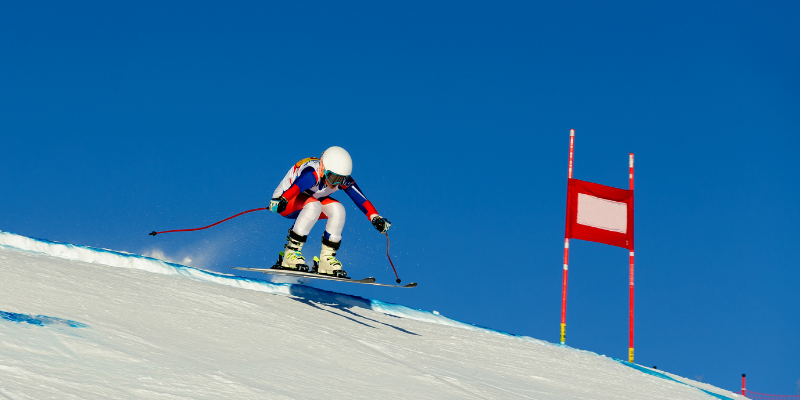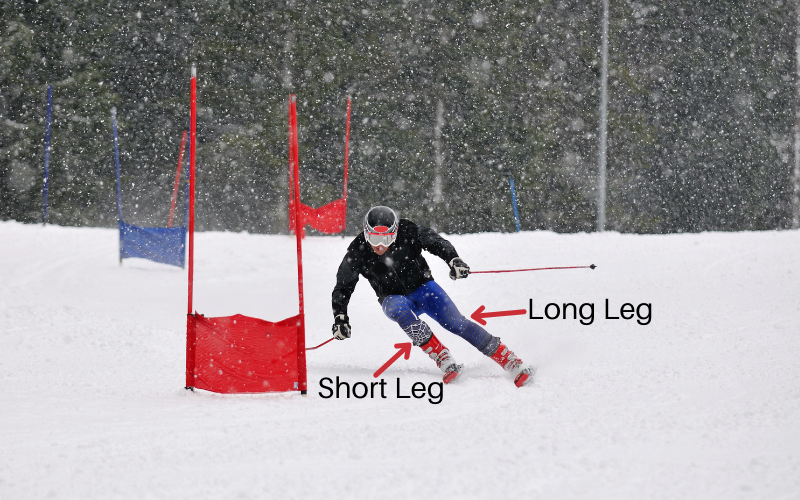Level up your skiing by practicing with flexed turn transitions.

As you progress as a skier, or get into ski racing, you will eventually want to consider your transition between turns. Most recreational skiers use extended transitions, where they rise up to unweight their skis between turns.
However, advanced/expert skiers and ski racers use flexed turn transitions, to increase the efficiency of their turns, leading to more fluid and dynamic skiing. With flexed transitions, you never rise up during the turn– you stay flexed in your athletic stance the entire time.
What is a flexed turn transition?
Flexed transitions allow you to ski faster, more efficiently, and with fewer movements (meaning a more effortless transition). It also allows you to better use the ski’s energy and engage your new ski edge faster to start the next turn. Flexed transitions also allow you to better absorb bumps in the snow while remaining smooth and fluid.
Body Positioning
While turning, you should always be leaning forwards, avoiding the “back seat” or “toilet bowl stance.” However, while doing a flexed transition, it is common and acceptable to get slightly into the back seat, and only for a very brief moment.
Elite skiers like Marcel Hirsher, Mikaela Shiffrin and Bode Miller are known to get a bit (or extremely) in the back seat during their turn transitions. Skiing like this takes enormous skill and leg muscle.
Skiing with flexed transitions will force you into the back seat a bit. Part of learning to execute flexed turn transitions is learning to get yourself forwards again after being thrown back.
Ankle Flexion
Solid ankle flexion is essential to a good flexed transition. In skiing, flexing and extending your legs comes from your knees and your ankles. This is part of why well-fitting ski boots are so important.
This is also why racing boots often come with the upper part of the boot angled a bit more forwards than typical recreational ski boots. They also tend to be very tight and stiff, for more precise control of the skis at high speeds and high pressure.
The “Ted Ligety Release“ — Early Release Transitions
Ted Ligety’s classic early release transition, ideal for giant slalom skiing, involves retracting/flexing the last turn’s outside ski so early that it is still on the uphill edge (the edge it was on during the previous turn).
During this type of transition, the ski very quickly will move to the new edge to rebalance the skier’s weight, thus starting the next turn. This technique is part of how Ligety dominates the competition with super high lines and smooth turns.
Long-leg Short-Leg
When you are making a turn, almost all of your weight should be on the outside ski. This leg is more extended than the inside ski, making it the “long-leg.” The inside leg is more flexed and carries almost no weight, making it the “short-leg.”
When executing a flexed turn transition, you are switching your long-leg with your short leg. For example, in a left turn, your right leg is your long-leg. In the transition to your next right turn, your right leg flexes to become your short leg, and your left leg extends to become your long-leg.
Utilizing long-leg short-leg is also part of how racers use their turns to generate speed. The physics are a lot to unpack, but essentially by driving the long-leg hard into its extension, the skier can drive more force into the turn.

Pushing off the Short Leg
Think about skating. When you skate on skis, you are pushing off of one ski onto the other (and repeat) to drive yourself forwards on flat or uphill terrain. During a turn, you can essentially push off the outside/long-leg ski to increase the force in your turn.
Instead of pushing off the ski into a step-like movement like skating, you are pushing off that ski into your turn transition. When doing this, you should feel the push coming from the front part of the ski– this indicates you are in the front seat, and the front part of the ski is best suited for providing energy in this push.
If you end up pushing off from the back of the ski, it can lead to skidding, which will severely hurt your speed, or it will lead to falling if the edge gets caught in the snow at a bad angle.
You can practice thinking about long-leg and short-leg in your skiing by paying attention to when you are flexing and extending your inner and outer legs during each turn.
Weighted Transitions
Similar to Ligety’s classic early release transition, a weighted transition does not involve any unweighting of the skis. It is a very dynamic way to turn and helps giant slalom skiers achieve high lines/early angles.
In a weighted transition, the skier flexes/retracts their inside leg during the transition, keeping all their weight on the previous turn’s outside ski throughout the whole transition and sometimes even keeping some weight on that previous outside ski into the start of the new turn.
The flexing of the old outside ski while tipping it into the new turn allows the skier to absorb energy from the turn. Because the old outside leg is so strongly flexed, it can very quickly move the body over the skis and into the new turn.
Moment of Unweighting
There is an inevitable moment, albeit a very short one, during this transition where both legs are in about the same state of flexion/extension. This is the moment of unweighting– some elite skiers even appear to hover above the ground for a second here, before coming down with their new turn’s outer ski to begin the next turn.
The ski is technically flat during this moment of unweighting, but it happens extremely quickly, so it appears to go directly from edge to edge to edge as one is making turns.
You still unweight your skis during a flexed transition (unless you are Ted Ligety), but you do not rise with your upper body. The unweighting happens almost entirely within your lower body.
Down-Unweighting
The unweighting of the skis during a flexed transition is often referred to as down-unweighting, because the skier remains in a down position during unweighing. In extended transitions, a skier instead uses up-unweighting, as they move upwards with their entire body to unweight their skis.
Down-unweighting somewhat forces you into the back seat during your turn transition. As mentioned before, this is absolutely okay during flexed transitions. However, it is crucial to immediately get your center of gravity back in the front seat as soon as you start reloading pressure onto your new outside ski, or as soon as you cross the fall line.
Work Your Way Up to Flexed Turn Transitions
In a flexed transition, everything happens extremely quickly. This is why it is good to practice and get very comfortable with extended transitions before working on flexed transitions.
Practicing extended transitions allows you to really feel each part of the transition and turn initiation, so when you work on mastering flexed transitions, you have muscle memory for what a good transition and turn initiation are supposed to feel like.
It is also good to practice staying in the front seat when you ski as you work on your flexed transitions. While it is fine and good to get in the back seat while executing a flexed transition, it is essential to quickly get back into the front seat when beginning the new turn. If you already have a bad back seat habit, working on flexed transitions before addressing it could make the habit worse, and could lead to some nasty crashes on the way.